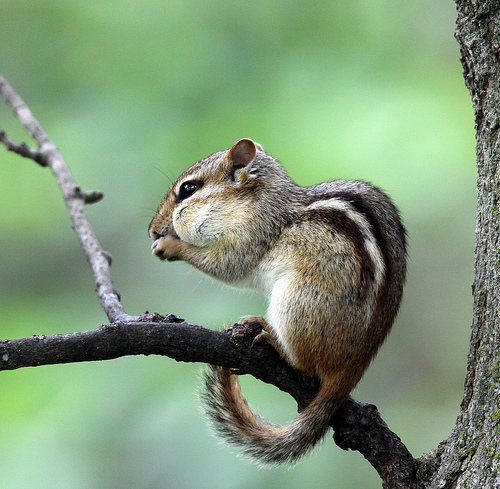Watch the chipmunks scurry over the rooftops.
- Chipmunks are small mammals that are primarily native to North America, but one of the 24 species is native to Asia.
- The scientific name of a chipmunk is ‘Tamias’, and they are from the family Sciuridae, the family of squirrels.
- Chipmunks mainly eat nuts, seeds, and berries, but also other vegetation, as well as insects, worms, frogs, bird eggs and fungi.
- Chipmunks live in burrows that can be 3.5 metres (11.5 feet) or longer, and they collect food in autumn that they store there for eating during the winter hibernation period.
- A chipmunk has flexible cheeks that allows it to obtain a number of food items at once, and it uses them as a carrying pouch.
Chipmunk
Image courtesy of Dawn Huczek/Flickr
- Chipmunks have calls that are similar in sound to chirps of a bird, and they have a lifespan generally of 2 or 3 years, and can have 2 to 8 babies in one litter.
- ‘Chipmunks’ are rodents, and are also known as ‘striped squirrels’, ‘timber tigers’, ‘munks’ and ‘chippers’.
- Different species of chipmunks are different colours, and range from brown, red-brown and grey in colour, and they have light and dark coloured stripes down their backs, face and tail.
- Chipmunks are commonly found in woodland habitats, but also live in urban areas, and are preyed on by foxes, weasels, coyotes, snakes and hawks.
- Chipmunks grow to be 10 to 18 cm (4 to 7 inches) in length, plus have a tail of 8 to 13 cm (3 to 5 inches) and weigh between 28 to 142 grams (1 to 5 ounces).
Bibliography:
Chipmunk, 2014, National Geographic, http://animals.nationalgeographic.com.au/animals/mammals/chipmunk/
Chipmunk, 2014, Wikipedia, http://en.wikipedia.org/wiki/Chipmunk








Chipmunks are one of my favourite animals. The best thing about chipmunks is that they adopt other children if their mother died or not at the place.